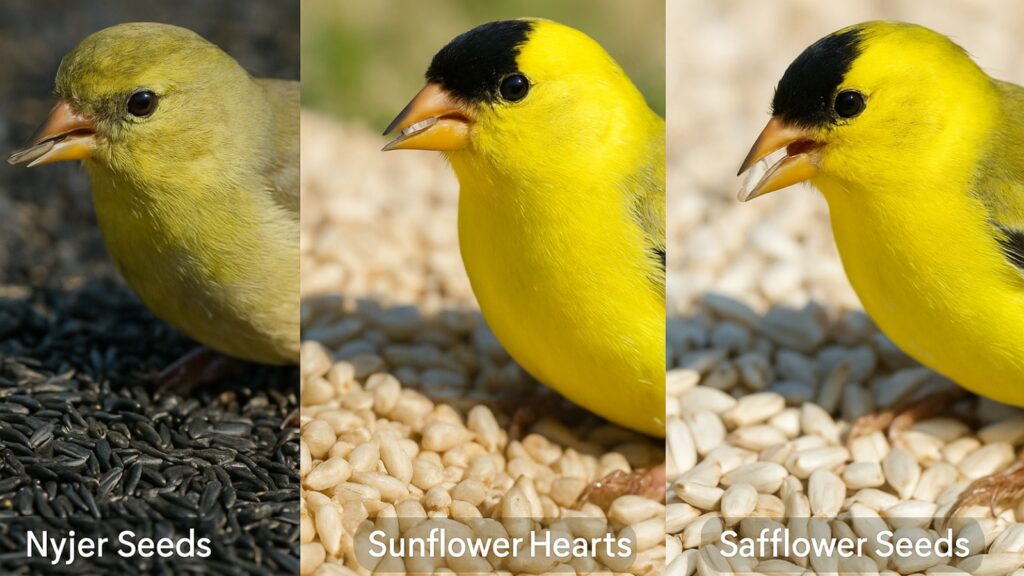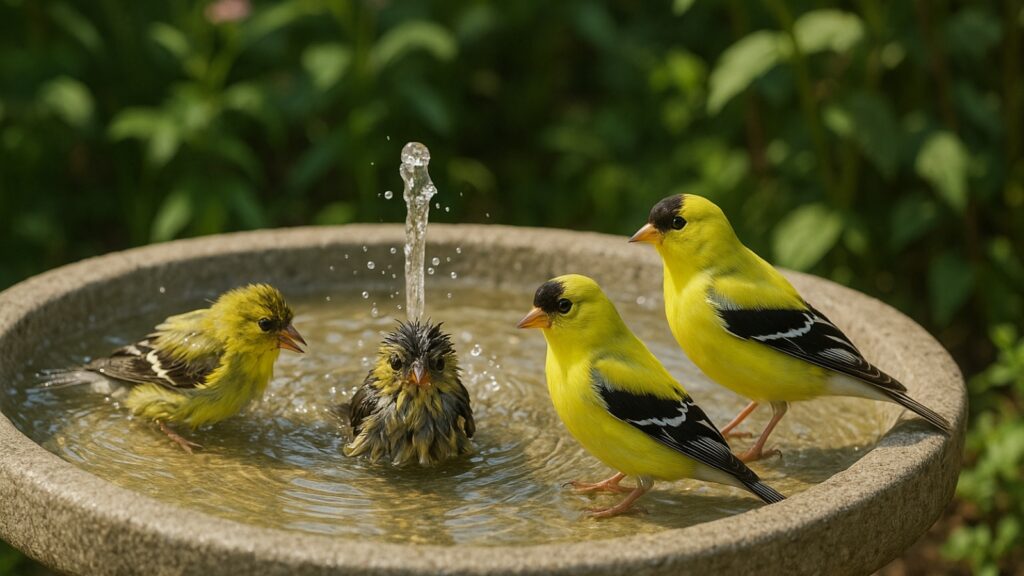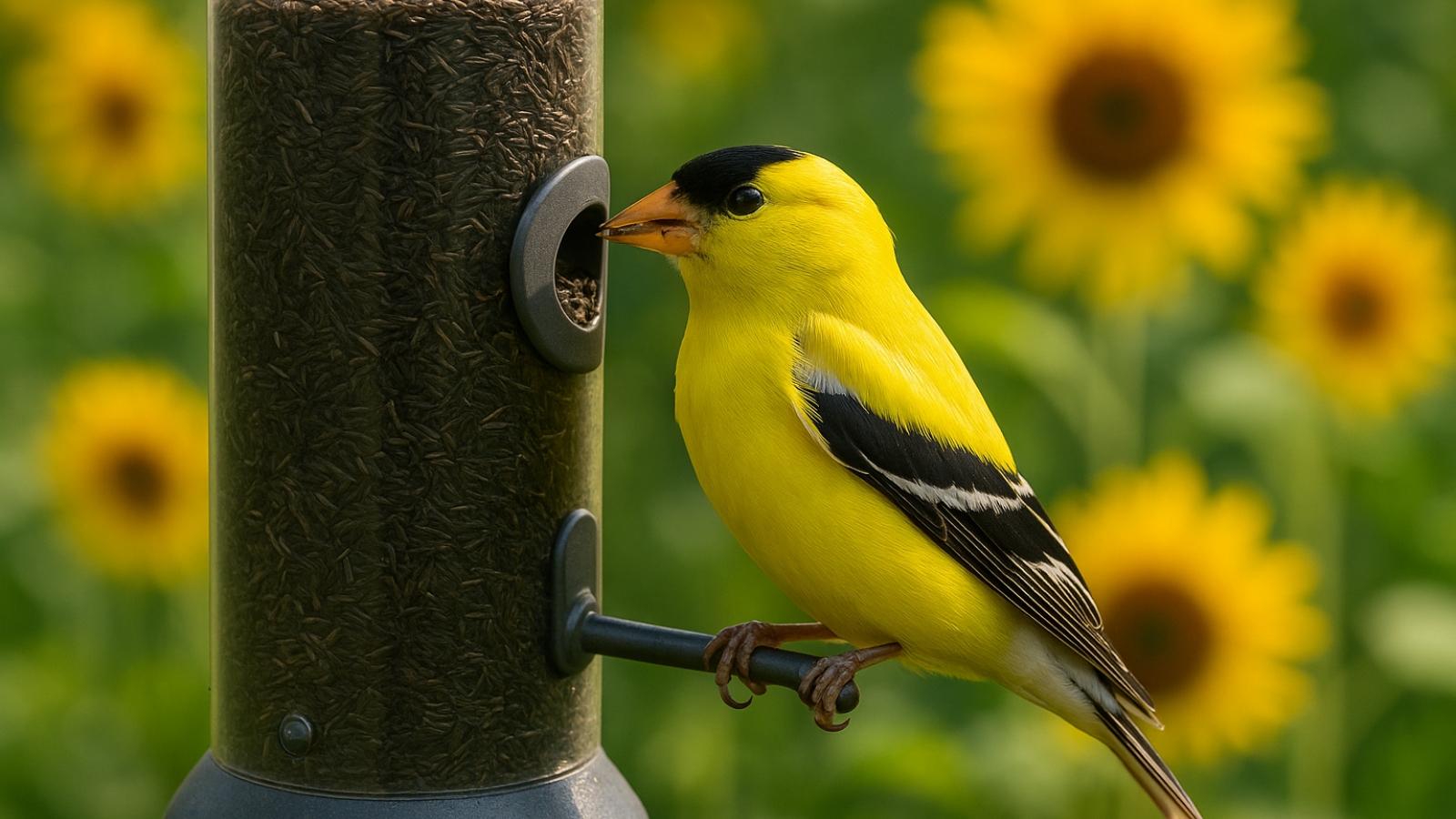Creating a goldfinch-friendly garden transforms your outdoor space into a vibrant sanctuary where these cheerful yellow birds will visit throughout the seasons.
American goldfinches are delightful garden visitors known for their bright breeding plumage and melodic calls, making them one of the most sought-after species for backyard birdwatchers.
Quick Answer
To attract goldfinches year-round, provide nyjer seed in mesh feeders, offer fresh water in shallow birdbaths, plant seed-producing flowers like sunflowers and coneflowers, maintain clean feeding stations, and create a natural habitat with dense shrubs for nesting. Goldfinches are particularly drawn to areas with a consistent food supply and safe shelter.
Key Takeaways
- Nyjer seed and sunflower hearts are goldfinches’ preferred food sources
- Tube feeders with fine mesh or small ports work best for goldfinch feeding
- Plant native seed-producing plants like sunflowers, coneflowers, and cosmos
- Provide shallow water sources no deeper than 1-2 inches
- Clean feeders every two weeks to prevent disease
- Create dense plantings for nesting cover during the breeding season.
Related Posts:
- Bird Seed Feeding – Learn about different types of bird seeds and feeding techniques
- What is a Bird Feeder? – Comprehensive guide to bird feeder types and selection
Understanding Goldfinch Behaviour Throughout the Year
American goldfinches display fascinating seasonal changes that influence their garden preferences. During spring and summer, males develop their iconic bright yellow breeding plumage with distinctive black caps and wing markings. This transformation occurs as they prepare for their unique late-summer nesting season, which differs from most songbirds.
Unlike many bird species, goldfinches delay nesting until July through September. This timing coincides with peak seed production from their favourite plants, ensuring abundant food for their young. During the winter months, both males and females adopt more subdued olive-brown colouring, helping them blend into the dormant landscape whilst they form larger feeding flocks.
Seasonal Migration Patterns
Goldfinches are partial migrants, meaning some populations migrate whilst others remain resident year-round. Northern populations typically move south for winter, whilst southern birds may only shift locally in response to food availability. Understanding these patterns helps explain why your goldfinch visitors might fluctuate throughout the year.
Essential Food Sources for Year-Round Attraction
Primary Seed Types

Nyjer seed (also called thistle seed) remains the gold standard for attracting goldfinches. These tiny, oil-rich seeds provide essential fats and proteins needed for energy and plumage development. Fresh nyjer seed is crucial – old or spoiled seed becomes bitter and less nutritious.
Sunflower hearts and chips offer another highly attractive option. Unlike whole sunflower seeds, these pre-shelled kernels reduce waste and attract goldfinches whilst deterring larger birds. The high oil content supports goldfinches through winter’s increased energy demands.
Safflower seed provides a third option, particularly useful if squirrels or larger birds dominate your feeders. Most mammals and aggressive birds avoid safflower’s bitter taste, leaving it for goldfinches and other smaller songbirds.
Seasonal Feeding Considerations
Spring feeding supports breeding preparation as goldfinches develop their bright mating plumage. High-quality seeds with adequate protein become especially important during this transformation period.
Summer feeding continues through the breeding season, with parent birds visiting feeders to supplement natural food sources whilst feeding nestlings. This is when understanding proper bird seed feeding techniques becomes most crucial.
Autumn and winter feeding helps sustain goldfinches through harsh weather when natural seeds become scarce. Increased feeder activity during these months reflects goldfinches’ gregarious winter behaviour as they form larger flocks.
Choosing the Right Feeders
Nyjer Seed Feeders
Tube feeders with fine mesh or tiny feeding ports work best for dispensing Nyjer seed. The small apertures prevent waste whilst accommodating goldfinches’ delicate beaks. Look for feeders with multiple perches to accommodate flocking behaviour.
Sock feeders offer an economical alternative, using fine mesh bags that goldfinches can cling to whilst feeding. These disposable options work well for testing goldfinch interest before investing in permanent feeders.
Upside-down feeders featuring perches above feeding ports cater to goldfinches’ natural feeding ability whilst deterring other species that cannot feed in this position.
Feeder Placement Strategies
Position feeders 5-10 feet from dense cover to provide escape routes from predators whilst maintaining clear sightlines for approaching birds. This distance allows goldfinches to feel secure whilst remaining accessible for observation.
Height placement between 4-6 feet accommodates goldfinches’ preferences whilst keeping feeders manageable for maintenance. Window feeders can provide excellent close-up viewing opportunities when positioned thoughtfully.
Multiple feeder locations reduce competition and accommodate goldfinches’ social feeding behaviour, particularly during winter when flocks can number in the dozens.
Creating a Goldfinch-Friendly Plant Garden
Native Seed-Producing Plants
Sunflowers reign supreme as goldfinch magnets. Both annual and perennial varieties produce abundant seeds that goldfinches harvest directly from flower heads. Plant various types for extended blooming periods and continuous seed production.
Coneflowers (Echinacea species) provide dual benefits: attractive summer blooms followed by seed heads that goldfinches devour. Leave spent flowers standing through autumn and winter for natural feeding opportunities.
Black-eyed Susans (Rudbeckia species) create similar benefits with their daisy-like flowers and abundant seeds. These hardy native plants thrive in various conditions whilst supporting goldfinch populations.
Cosmos and zinnias offer annual options that produce copious small seeds perfect for goldfinches’ tiny beaks. These colourful flowers brighten gardens whilst providing natural food sources.
Landscaping for Natural Habitat
Dense shrub plantings provide essential nesting sites during goldfinches’ late-summer breeding season. Dogwood, elderberry, and viburnum species offer both cover and additional food sources through their berries and the insects they attract.
Allowing some garden areas to “go wild” with native grasses and wildflowers creates natural seed sources whilst providing nesting materials. Goldfinches use plant fibres, particularly from thistles and other composites, to construct their remarkably waterproof nests.
Creating layered vegetation with ground cover, shrubs, and small trees mimics a natural habitat whilst providing multiple microenvironments that support goldfinches throughout their annual cycle.
Water Requirements and Birdbath Setup
Optimal Water Features

Goldfinches require shallow water for both drinking and bathing. Birdbaths should maintain depths of 1-2 inches maximum, allowing these small birds to wade safely without fear of drowning. Sloped basin designs provide multiple depth options within a single water source.
Moving water significantly increases attraction. Simple water wigglers or small fountains create ripples and sounds that draw goldfinches from considerable distances. The motion also prevents water stagnation and reduces mosquito breeding.
Textured surfaces prevent slipping, making concrete or ceramic birdbaths preferable to smooth plastic or metal versions. Adding small stones or branches provides additional perching spots and grip for nervous bathers.
Seasonal Water Maintenance
Summer maintenance involves frequent cleaning and refilling as heat increases evaporation and algae growth. Position birdbaths in partially shaded locations to maintain comfortable water temperatures whilst preventing rapid evaporation.
Winter water provision becomes challenging in freezing climates. Heated birdbaths or de-icers ensure consistent water access throughout cold periods. Even brief daily availability helps sustain goldfinch populations through harsh weather.
Regular cleaning every few days prevents disease transmission amongst visiting birds. Use diluted bleach solutions weekly, followed by thorough rinsing, to maintain sanitary conditions.
Feeder Maintenance and Hygiene
Cleaning Protocols
Feeder hygiene prevents disease outbreaks that can devastate local bird populations. Clean feeders every two weeks minimum, increasing frequency during wet weather or periods of heavy use. Remove all old seed before refilling to prevent spoilage and contamination.
Use hot, soapy water followed by a 10% bleach solution for thorough sanitisation. Rinse completely and allow feeders to dry thoroughly before refilling. This protocol eliminates bacteria, fungi, and parasites that cause avian diseases.
Observe feeding birds for signs of illness, including lethargy, ruffled feathers, or difficulty feeding. Remove feeders immediately if sick birds appear, cleaning thoroughly before resuming feeding after several days.
Seed Storage and Quality
Store seeds in cool, dry locations using airtight containers to prevent spoilage and pest infestations. Metal containers with tight-fitting lids work best for protecting seed quality and deterring rodents.
Check stored seeds regularly for signs of mould, insects, or rancidity. Fresh Nyjer seed should have a pleasant, nutty aroma, whilst spoiled seed develops musty or sour odours. Discard questionable seed immediately to prevent harming visiting birds.
Purchase seeds from reputable suppliers and avoid bulk quantities that exceed reasonable usage within 2-3 months. Fresher seeds provide better nutrition and attract more birds consistently.
Creating Year-Round Habitat
Spring Preparation
Begin spring preparation by cleaning and servicing all feeders and water sources before goldfinches return from winter ranges or begin breeding activities. Fresh seed supplies and clean equipment ensure ready hospitality for returning birds.
Plant new seed-producing flowers and maintain existing plantings to support increasing goldfinch populations through the breeding season. Early preparation allows plants to establish before peak nesting periods.
Avoid disturbing potential nesting areas during spring cleaning activities. Goldfinches prefer undisturbed dense vegetation for nest placement, making careful timing essential for successful breeding support.
Summer Breeding Support
Maintain consistent feeding throughout summer’s breeding season, when parent goldfinches supplement natural foods with feeder offerings. Increased activity during this period reflects breeding birds’ heightened energy requirements.
Provide natural nesting materials by allowing thistle, cottonwood, and other fibrous plants to go to seed. Goldfinches collect these materials for constructing their remarkably waterproof nests.
Avoid pruning or major garden disturbances during July through September when goldfinches actively nest. Late-season breeding makes them vulnerable to habitat disruption when most other birds have completed nesting.
Autumn and Winter Preparation
Increase feeder capacity and frequency of filling as goldfinches form larger winter flocks. Multiple feeding stations reduce competition and accommodate increased bird numbers during cold months.
Leave seed heads standing on coneflowers, sunflowers, and other native plants through autumn and winter. These natural food sources provide essential backup nutrition whilst adding visual interest to winter gardens.
Prepare water sources for freezing weather using heated elements or positioning in protected locations. Consistent water access becomes more critical as natural sources freeze or become inaccessible.
Troubleshooting Common Issues
Lack of Goldfinch Visitors
Feeder placement issues often prevent goldfinch visits. Ensure feeders are positioned away from high-traffic areas whilst remaining accessible for regular maintenance. Goldfinches are naturally cautious and avoid busy locations.
Seed quality problems frequently deter goldfinches. Old, stale, or contaminated nyjer seed lacks appeal and nutritional value. Replace questionable seed with fresh supplies from reputable sources.
Competition from aggressive birds or squirrels can overwhelm goldfinches. Use weight-activated feeders or caged designs that exclude larger animals whilst permitting goldfinch access.
Inconsistent Visitation
Seasonal behaviour naturally causes visitation fluctuations as goldfinches respond to breeding cycles, weather patterns, and food availability. Understanding these patterns helps manage expectations whilst maintaining consistent feeding practices.
Local habitat changes can redirect goldfinch movements. New development, removal of nearby plants, or changes in neighbouring feeding practices might affect your garden’s attractiveness to these birds.
Patience remains essential when establishing goldfinch feeding stations. These birds are creatures of habit and may require weeks or months to discover and trust new food sources.
Feeder Domination by Other Species
House finches and other birds sometimes overwhelm goldfinch feeders. Use specialised nyjer feeders with tiny ports that accommodate goldfinches whilst excluding larger species. Understanding the benefits of using a window bird feeder can help you make strategic choices.
Squirrel interference requires baffles, weight-activated mechanisms, or strategic positioning. Place feeders at least 4 feet high and 8 feet from jumping surfaces to prevent squirrel access.
Reduce competition by offering multiple feeding stations with different seed types. This approach accommodates various species whilst ensuring goldfinches have dedicated access to their preferred foods.
Advanced Attraction Techniques
Companion Plantings
Pollinator gardens support the insects that goldfinches feed to their nestlings. Native wildflowers and herbs attract diverse insects whilst providing secondary food sources through their seeds.
Three-season gardens with spring, summer, and autumn-blooming plants extend natural food availability throughout goldfinches’ active periods. Succession planting ensures continuous resource availability.
Native plant communities that evolved with goldfinches provide optimal habitat and food sources. Research local native plant societies for region-specific recommendations tailored to your area’s goldfinch populations.
Integrated Pest Management
Avoid pesticides and herbicides that eliminate the insects that goldfinches feed to their young. Organic gardening practices support the entire ecosystem whilst maintaining safe environments for visiting birds.
Encourage beneficial insects through diverse plantings and chemical-free maintenance practices. Healthy insect populations support goldfinch breeding success whilst controlling garden pests naturally.
Use companion planting strategies that naturally deter harmful insects whilst attracting beneficial species. This approach creates balanced ecosystems that support both garden health and bird populations.
Seasonal Maintenance Calendar
Monthly Tasks
January-February: Deep clean all feeders and water sources. Service heating elements and assess equipment needs for spring preparation. Order fresh seeds and plan new plantings.
March-April: Begin spring feeder setup and increase feeding frequency. Clean and prepare birdbaths for increased activity. Start seeds for annual pollinator plants indoors.
May-June: Plant summer-blooming seed-producing flowers. Maintain consistent feeding as the breeding season approaches. Monitor for early nesting activity in dense cover areas.
July-August: Peak breeding season requires consistent feeding and minimal garden disturbance. Document nesting locations for future reference. Begin planning autumn native plant additions.
September-October: Increase feeder capacity for winter flocking behaviour. Leave seed heads standing on spent flowers. Begin winter equipment preparation and water source protection.
November-December: Monitor winter visitors and adjust feeding frequency accordingly. Protect feeders from harsh weather. Plan next year’s garden improvements based on current season observations.
Conclusion
Attracting goldfinches to your garden year-round requires understanding their unique behaviours, providing consistent food and water sources, and creating a habitat that supports their complete annual cycle. Success comes from combining proper feeder selection, quality seeds, appropriate plantings, and diligent maintenance practices.
The reward of watching these charismatic birds transform your garden into a vibrant ecosystem justifies the effort required. Goldfinches bring colour, movement, and delightful vocalisations that enhance any outdoor space whilst supporting local biodiversity and ecosystem health.
Remember that creating a goldfinch habitat benefits numerous other species, from beneficial insects to native plant communities. Your efforts contribute to broader conservation goals whilst providing personal enjoyment and educational opportunities for years to come.
Start with basic feeding stations and water sources, then gradually expand your goldfinch-friendly features as you observe their preferences and behaviours. Consistency and patience will reward you with regular goldfinch visitors throughout the seasons.
For those interested in expanding their bird-attracting efforts, consider exploring tips for attracting hummingbirds to your garden and learning about an essential guide to bird baths to create a comprehensive backyard bird habitat.
FAQ
Q: What is the best type of feeder for goldfinches?
A: Tube feeders with fine mesh or small ports specifically designed for Nyjer seed work best. These feeders prevent waste whilst accommodating the goldfinches’ feeding behaviour. Avoid feeders with large ports that allow seed spillage.
Q: How often should I clean goldfinch feeders?
A: Clean feeders every two weeks minimum, or more frequently during wet weather or heavy use periods. Use hot soapy water followed by a 10% bleach solution, then rinse thoroughly before refilling with fresh seed.
Q: Why aren’t goldfinches visiting my feeder?
A: Common causes include stale seed, poor feeder placement, competition from other species, or lack of nearby cover. Ensure you’re using fresh nyjer seed, position feeders near natural shelter, and maintain consistent filling schedules.
Q: When do goldfinches nest?
A: Goldfinches nest later than most birds, typically from July through September. This timing coincides with peak seed production from their favourite plants, ensuring abundant food for raising young.
Q: What plants attract goldfinches naturally?
A: Sunflowers, coneflowers, black-eyed Susans, cosmos, and zinnias are excellent choices. These seed-producing plants provide natural food sources whilst adding beauty to your garden.
Q: Do goldfinches migrate?
A: Goldfinches are partial migrants. Northern populations typically move south for winter, whilst southern birds may remain resident or move only locally. This varies by region and local conditions.
Q: How deep should water be for goldfinches?
A: Keep birdbath water 1-2 inches deep maximum. Goldfinches are small birds that need shallow water for safe drinking and bathing. Sloped basins providing multiple depths work best.
Q: What other birds eat nyjer seed?
A: House finches, siskins, redpolls, and other small finches also eat nyjer seed. However, properly designed feeders can accommodate multiple species without excluding goldfinches.
Q: How can I deter squirrels from goldfinch feeders?
A: Use weight-activated feeders, baffles, or position feeders at least 4 feet high and 8 feet from jumping surfaces. Safflower seed also deters squirrels whilst remaining attractive to goldfinches.
Q: Should I feed goldfinches year-round?
A: Yes, year-round feeding supports goldfinches through all seasons, particularly during harsh winter weather and the breeding season when energy demands increase. Consistent feeding helps establish regular visitation patterns.
Q: What time of day are goldfinches most active?
A: Goldfinches typically show peak activity during morning and late afternoon hours. However, they may feed throughout the day, particularly during the breeding season or adverse weather conditions.
Q: How many goldfinches can I expect at my feeders?
A: Numbers vary seasonally and regionally. During the breeding season, expect smaller groups or pairs. Winter flocks can include dozens of birds, making adequate feeder capacity and multiple feeding stations important.
Sources:
Audubon. “American Goldfinch Field Guide.” Audubon Field Guide. https://www.audubon.org/field-guide/bird/american-goldfinch.
